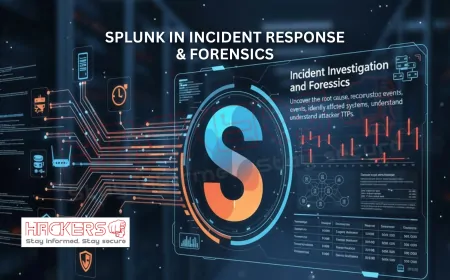What Are Common Mistakes to Avoid While Using Splunk?
Splunk turns complex machine data into actionable insights. From IT operations to security and business analytics, it powers decision-making across industries. But even in a city like Pune, where tech teams are sharp and agile, small missteps in Splunk can lead to big problems: slow searches, bloated storage, or missed alerts. This guide is written with beginners and intermediate users in mind. Whether you're managing logs from a local data center or monitoring cloud workloads, avoiding these common mistakes will help you get more value from Splunk, faster and cheaper.

Table of Contents
- Not Planning Data Ingestion Properly
- Ignoring Index Management
- Writing Inefficient Searches
- Overlooking User Roles and Permissions
- Neglecting Data Source Validation
- Failing to Use Sourcetypes Correctly
- Skipping Regular Backups
- Misconfiguring Time Zones
- Not Using Field Extractions Wisely
- Ignoring License Usage
- Poor Dashboard Design
- Not Testing Alerts Thoroughly
- Overloading Forwarders
- Ignoring Knowledge Objects Sharing
- Not Monitoring Splunk Health
- Summary Table of All Mistakes
Not Planning Data Ingestion Properly
Many teams in Pune start forwarding logs from every server without asking: "Do we really need this data?" This leads to license overages and slow searches.
- Avoid ingesting debug logs from development servers into production indexes.
- Use
inputs.confwithwhitelistandblacklistto filter early. - Test small data samples before full rollout.
Ignoring Index Management
Indexes are where Splunk stores data. Without proper sizing and retention, your cluster fills up fast.
- Create separate indexes:
security,web,app. - Set
frozenTimePeriodInSecsbased on compliance (e.g., 90 days for PCI, 30 days for app logs). - Archive cold data to cheaper storage.
Writing Inefficient Searches
A search like * error scans every event. That’s a performance killer.
- Always start with:
index=web sourcetype=access_combined - Avoid leading wildcards.
- Use
| tstatsfor summarized data when possible.
Overlooking User Roles and Permissions
Giving everyone admin access is common in small teams, but risky.
- Create roles:
analyst(read-only),developer(own app),soc(security index). - Use
srchIndexesDefaultto limit visible indexes. - Audit logins monthly.
Neglecting Data Source Validation
Adding a new log source without preview leads to unparsed events.
- Use Splunk’s “Add Data” with preview enabled.
- Check timestamp recognition and line breaking.
- Verify key fields like
user,status,urlare extracted.
Failing to Use Sourcetypes Correctly
Using generic_single_line for everything means no automatic field extraction.
- Use built-in sourcetypes:
access_combined,cisco:asa,linux_secure. - Rename during onboarding if needed.
Skipping Regular Backups
Lost a dashboard during upgrade? It happens.
- Export apps weekly via UI or CLI.
- Store in Git or backup server.
- Test restore process quarterly.
Misconfiguring Time Zones
Servers in different regions send logs in local time. Splunk may misalign them.
- Set
TIME_ZONEinprops.confper sourcetype. - Use
| eval _time = _time + offsetif needed.
Not Using Field Extractions Wisely
Extracting 50 fields at search time slows every query.
- Extract high-use fields (like
user,src_ip) at index time. - Use search-time for rare fields.
Ignoring License Usage
Splunk stops indexing at midnight if you exceed daily limit.
- Check license usage in
Settings > Licensing. - Set alert at 80% via saved search.
- Drop noisy events with
NULLQUEUE.
Poor Dashboard Design
Too many panels = slow load time.
- One dashboard, one purpose.
- Use tokens for drill-down.
- Pre-run searches with
| stats.
Not Testing Alerts Thoroughly
Alerts that fire every minute annoy everyone.
- Test in “Report” mode first.
- Use
trigger onceand suppression. - Simulate real events.
Overloading Forwarders
One forwarder monitoring 100+ inputs strains the host.
- Monitor CPU/memory on forwarder hosts.
- Use lightweight universal forwarders.
- Batch outputs.
Ignoring Knowledge Objects Sharing
Dashboards saved as private help no one.
- Share in team apps.
- Use permissions:
read,write. - Document purpose in description.
Not Monitoring Splunk Health
Splunk monitors your systems. Who monitors Splunk?
- Use Monitoring Console.
- Alert on indexer crashes, search errors, queue blocks.
- Review
_internalindex daily.
Summary Table of All Mistakes
| Mistake | Impact | Quick Fix |
|---|---|---|
| No Ingestion Plan | License overage, slow system | Filter at forwarder with whitelist |
| Poor Index Setup | Storage full, high cost | Set retention in indexes.conf |
| Slow Searches | User frustration | Start with index + sourcetype |
| Weak Permissions | Security breach risk | Custom roles with least access |
| No Data Preview | Unparsed events | Use Add Data wizard |
| Wrong Sourcetype | No auto fields | Use access_combined, etc. |
| No Backups | Lost configs | Export apps weekly |
| Time Zone Mix-up | Wrong event order | Set in props.conf |
| Search-Time Fields | Slow queries | Index-time for key fields |
| License Blindness | Indexing stops | Alert at 80% |
| Cluttered Dashboards | Slow load | One topic per dashboard |
| Untested Alerts | False positives | Test in report mode |
| Overloaded Forwarders | Host crash | Monitor resources |
| Private Knowledge Objects | Siloed work | Share in apps |
| No Splunk Monitoring | Blind to issues | Use Monitoring Console |
Table uses border: 1px solid #000; and padding: 8px; on all and via inline styles.border-collapse: collapse; ensures clean, visible grid lines.
Conclusion
Splunk is a game-changer when used right. Avoid these 15 common mistakes, and you'll save money, reduce alert fatigue, and deliver faster insights. Start with a solid ingestion plan, secure your environment, and keep learning. Teams in Pune and beyond are using Splunk to stay ahead. Now it's your turn.
What is Splunk used for?
Splunk collects and analyzes machine data (logs, metrics) for IT, security, and business use cases.
How do I avoid license overages?
Filter events at the forwarder using props.conf and NULLQUEUE. Monitor daily in Licensing.
What are indexes in Splunk?
Containers that store events. Organize by data type: main, security, web.
Why is my search taking forever?
You're likely scanning too much data. Always filter by index and sourcetype first.
How do I set data retention?
In indexes.conf: frozenTimePeriodInSecs = 7776000 (90 days).
What is a sourcetype?
A label that tells Splunk how to parse data (e.g., access_combined for Apache logs).
How do I create user roles?
Settings > Access Controls > Roles > New Role. Assign capabilities and index access.
What happens if I exceed my license?
Indexing stops at midnight. Data in forwarder queues may be lost.
How do I back up dashboards?
Export the app containing the dashboard via Settings > Apps.
What is the Monitoring Console?
A built-in Splunk app to monitor deployment health, performance, and indexing.
How do I extract fields?
Use rex in search, or define in props.conf for index-time extraction.
Why are timestamps wrong?
Check time zone in props.conf or ensure forwarder clock is synced.
What are forwarders?
Lightweight agents that collect and send data to Splunk indexers.
How do I make fast dashboards?
Use summarized searches, limit panels, and enable acceleration if needed.
How do I avoid duplicate events?
Use crcSalt in inputs.conf or monitor file paths uniquely.
What is index-time vs search-time extraction?
Index-time: permanent, fast. Search-time: flexible, slower.
How do I test alerts?
Save as report, schedule, and simulate triggering conditions.
Should I share knowledge objects?
Yes. Use apps with role-based permissions for team collaboration.
How do I monitor forwarders?
Use index=_internal sourcetype=splunkd component=Metrics group=per_source_thruput.
Where can I learn more?
Splunk Docs, Splunk Lantern, and local user groups in Pune.
What's Your Reaction?










































































